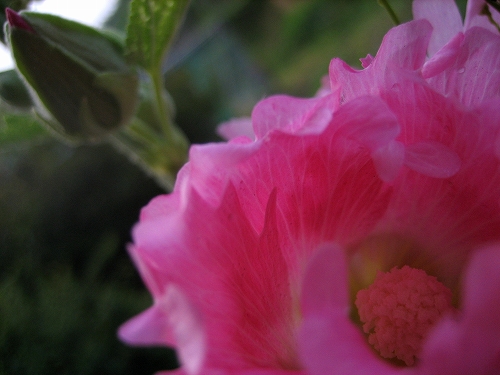目には青葉 山ほととぎす 初鰹 「つれづれ樹」 [育まれる(歴史)]

「 目には青葉 山ほととぎす 初鰹 」
1,600年代江戸中期の作品
初鰹・時鳥は初夏で 目には“若葉”でしょう。
“青葉”は 日本古来よりの表現形式 だからか違和感ない。
それでも、緑色を「青色表現」するものが多い。
緑色なのに、「青リンゴ」「青汁」「青のり」「青虫」「青しそ」
「青ねぎ」「青菜」「青々と茂る」などが現在も残っている。
万葉集などでは、
赤色&青色 という“色味”表現よりも、
“鮮やか” “淡い” “暗い” “明るい”
に、より重心を置いた方途が 好まれたようです。
決して 栄養環境が悪くて “色弱”ではない。
“鮮やか” “暗い” “明るい” “淡い”
「明(あ)かし」 「暗(くら)し」 「顕(しる)し」 「漠(あを)し」
“赤” “黒” “白” “青”
http://www.bs-j.co.jp/iro/series/02.html
茜色(あかね)、萌黄色(もえぎ)、露草色(つゆくさ)、女郎花色(おみなえし)、橡色(つるばみ)
「茜草指 紫野行き 標野行き 野守は見ずや 君が袖ふる」 (万葉集)
あかねさす むらさきのゆき しめのゆき のもりはみずや きみがそでふる
「つき草の 移ろひやすく 思へかも わが思う人の 言も告げ来ぬ」(万葉集)
つきくさの うつろひやすく おもへかも わがもうひとの こともつげきぬ
「名にめでて 折れる計ぞ 女郎花 われおちにきと 人に語るな」 (古今集)
なにめでて おれるばかりぞ おみなえし われおちきにと ひとにかたるな
「紅は 移ろふものそ 橡の 馴れにしし衣に なほ若かめやも」 (万葉集)
くれないは うつろふものそ つるばみの なれにししきぬに なほしかめやも
茜色、萌黄色、露草色、女郎花色、橡色などが 万葉集でもちいれられてる。
現在でいう 赤緑青黄黒などの“色相表現”とは異なって、、。
それぞれの色が 自然にある色相によって、
自然にあるその瞬間の色合いによって、
現実と直接に対面した状態の 色表現がなされる。。。
今の私たちは
一般的には 12色位の“色概念”で
自然にある色相を表現しようとしてる。
自然と直接対峙して感じられる色を
12色の色合いで表現してしまいがちです。
語源として、
赤は、 「明(あ)かし ←“鮮やかなもの”」
黒は、 「暗(くら)し ←“暗いもの”」
白は、 「顕(しる)し ←“明るいもの”」
青は、 「漠(あを)し ←“淡いもの”」
とするように言われておりますが、、
庶民ではない貴族社会における 詩歌表現では、
“うつろい”が 主題だったのでしょうか。
栄枯盛衰
”色鮮やか”なものの うつろい
”みしるし”の強いものの うつろい
白と黒は 対義語ではなかった
“赤”の対義語 “黒” “白”の対義語 “青”
色鮮やかなものは 日が暮れかかれば 「黒」
顕しの強いもんは 日が暮れかかれば 「青」
「貴族社会の狭さ」きうちに
自分自身を映しこむ表現の なんと多いことか、、、
http://blogs.yahoo.co.jp/iwakuratei8823/420042.html
★万葉びとの色彩感覚
現代の日本語においては、色の違いは基本的に、色相が異なることを意味する。では、古代ではどうだったのだろうか。
古代の日本語の色を表す形容詞は色相を示すものではなかったようだ。「赤」「黒」「白」「青」はそれぞれ、形容詞の「明(あ)かし」、「暗(くら)し」「顕(しる)し」「漠(あを)し」からきた語と考えられており、これは光の明暗濃淡を意味するもの、つまり明度を表したもので、色相ではなかったのだ。
古代では「赤」と「黄」がほとんど同じ色彩として認識されていた。たとえば、「もみじ」が、『万葉集』では「紅葉」とも「黄葉」とも表記されたのは、赤と黄を明確に区別しなかったためといわれている。言い換えると、古代では色彩の捉え方が現代と違って色相ではなく、彩度と明度を基本としていたのである。
「赤」は、彩度が高い状態、つまり、色が鮮明であることを表現する語であった。これが、古代日本語において「赤」と「黄」の区別が曖昧となった理由と思われる。「赤」と「明るい」がともに「あか」という語根を共有するのは、「赤」の語源が「明るい」であったことによるものだ。
一方、青は淡い色(淡色)と関係がある。つまり青は彩度が小さい色彩を表現する語彙だったと考えられるのだ。古代においては、水色、桃色、灰色などが一括して「青(あを)」と呼ばれていた。、また、薄い灰色が青と表現されたことは、「青雲(あをくも)」という言葉にも残されている。
『枕草子』の「なまめかしきもの」にも、「あをき薄様(うすやう)に書きたる文つけたる」とある。墨色を表したこの「あをき」と「薄様」は、ほぼ同格である。
一方、白と黒は明度の大小に対応した語で、白は古代語においては、「白い」というよりも、「輝く」に近い意味を有していた。黒は、光のない状態、すなわち「暗い」が原義だったと考えられる。以上の関係をまとめると、以下のようになる。
大 ← 明度 → 小 大 ← 彩度 → 小
白 黒 赤・黄 青
顕 暗 明 淡
古代人の色彩感覚については、「古代日本語における色名の性格」佐竹昭弘著がたいへん参考になる。『萬葉集抜書』(岩波書店刊、昭和55年[1980])に収められているが、最近では文庫版も出ているようだ。
IXYDIGITAL60(ISO50)&PHOTOSYOP
< 生業ですが、アバウトです! お気に召せば 遡って画像は ご自由に転載&ご利用下さい。 >
太郎さんのお薦め
【杉本商会】
http://web1.kcn.jp/ishi_hal/Welcome.html
(木工芸・杉玉・お茶を 扱われてます。)
【十津川荘】
http://www.102k.net/
(十津川行くなら 太郎のお薦め!!!!)
以下は、エキサイト翻訳になります。
A bird is early summer at the time of work first-bonito-of-the-season - in the middle of the 1,600s "being [ the green-leaves mountain little cockoo first bonito of the season ]-in eyes" Edo. Probably, it is "verdure" at eyes. [ it ] "Green leaves" Expressive form from Japanese ancient times Therefore, it is comfortable in or. red, & blue in the Ten Thousand Leaves と -- "color clever" to say -- "fresh"er than expression -- 方途 which put the center of gravity on "being "light", "dark", and bright" more It seems that it was fond. Never Nutrient environment is bad. It is not "color weakness." "fresh" -- "it being dark" "bright" and "light" -- "-- 明 (あ) -- lending -- " -- "carrying out dark (く et al.)" -- "Carrying out 漠 of the あ". [ "carrying out 顕 (carrying out る)" and ] "Red" "Black" "White", "blue" a http://www.bs-j.co.jp/iro/series / 02.html dark red (dirt), grass green (burning ぎ), Russian green (つ -- it dies), and Patrinia scabiosaefolia color (Patrinia scabiosaefolia) and 橡色 (vine ばみ) "-- 標野 going [ for 茜草指 Shino ] Nomori does not see -- Mr. や -- 袖ふる" It puts in dirt (Ten Thousand Leaves). purple -- dying A bundle dies. piling -- not seeing -- や you -- sleeve ふる "-- attaching -- herbal 移ろひ -- easy -- 思 [ ] -- word of my those that consider is also told, and does not come -- " (Ten Thousand Leaves) -- with くさ hollow ひ -- easy -- Or [ main へ ] my -- already -- ひ also pour things -- きぬ " love to a name and break -- the total -- don't tell き and people at a Patrinia scabiosaefolia crack funny punch line -- " eye what (Collection from Ancient and Modem Times) -- て be -- about る Patrinia scabiosaefolia dividing and falling -- きに Barrel [ ひ ] carrying out by making "red tameness of そ Quercus acutissima of 移ろふ -- clothes -- なほ若 or め -- " giving (Ten Thousand Leaves) -- there is nothing -- そ of hollow ふ Vine ばみの carrying out [ it is alike and ] and spreading -- ぬ Eye a なほ deer A dark red, grass green, Russian green, and Patrinia scabiosaefolia color, 橡色, etc. It is held by the Ten Thousand Leaves. It says at the present. It differs from "hue expression" of red verdigris 黄黒 etc. Each color The state where it met reality and directly by the instantaneous tone which exists automatically by the hue which exists automatically Color expression is made. . . Present us Are general. It is going to express the hue which exists automatically with the "color concept" of about 12 colors. The color felt by confronting each other nature and directly tends to be expressed by the tone of 12 colors. as the origin of a word -- red -- "-- carrying out in 明 (あ) -- skillful "thing"" black -- "-- carrying out dark (く et al.) -- dark "thing"" white -- "-- carrying out 顕 (carrying out る) -- bright "thing"" blue -- "-- although it is said that 漠 of the あ is carried out and it is considered as "light thing"" It can set to the aristocrat who is not people. "Hollow い" is at 詩歌. Was it the theme? Rise and fall Vivid thing Hollow い Thing which has a strong mark and which sees Hollow い 対義語 "blue" white and black of "red" 対義語 "black" and "white" It was not 対義語. Vivid thing If it is growing dark "Black" Strong いもん of 顕し If it is growing dark "Blue" 狭さき of aristocratic circles -- expression which projects self on inside and is crowded Very large things,




コメント 0